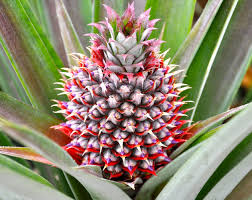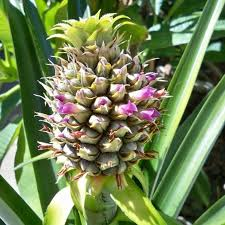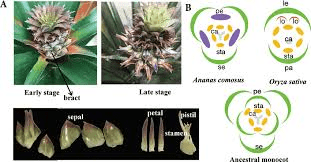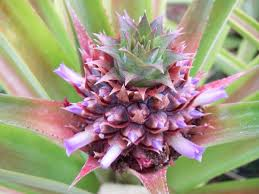Pineapple flowers are a fascinating aspect of the pineapple plant (Ananas comosus), which belongs to the Bromeliaceae family. These flowers play a crucial role in the development of the pineapple fruit, showcasing unique botanical features and an interesting flowering process.
The pineapple plant typically grows in tropical and subtropical regions, thriving in warm, sunny climates with well-drained soils. The plant itself has a rosette of stiff, spiny leaves, which can reach up to 1.5 meters in length. At the center of this rosette, a flowering stalk, or inflorescence, emerges.
The flowering process of a pineapple plant begins with the formation of a central flower spike, known as the peduncle, which can grow up to 15-20 centimeters long.
The inflorescence of a pineapple is a cluster of individual flowers, often referred to as a flower head. Each pineapple flower is small, tubular, and typically ranges in color from pale lavender to deep purple. The flowers are arranged in a spiral pattern around the central axis of the inflorescence, creating a compact, cylindrical shape. The number of flowers in an inflorescence can vary, but it usually consists of 100 to 200 individual flowers.
Each pineapple flower consists of three main parts: the sepals, petals, and reproductive organs. The sepals, also known as the calyx, are the outermost part of the flower and are typically green and leaf-like. They protect the developing flower bud before it opens. Inside the sepals are the petals, which are usually fused together to form a tubular structure.
The petals are often brightly colored, attracting pollinators such as hummingbirds and insects. However, in commercial pineapple cultivation, natural pollination is usually not desired, as it can result in the formation of seeds within the fruit, which are considered undesirable.
The reproductive organs of the pineapple flower include the stamens and the pistil. The stamens are the male reproductive organs, consisting of a filament and an anther, which produces pollen. The pistil is the female reproductive organ and is located at the center of the flower.
It consists of an ovary, style, and stigma. The ovary contains ovules, which, if fertilized, will develop into seeds. However, as mentioned earlier, seed formation is typically avoided in commercial pineapple cultivation.
After the flowering process, the individual flowers begin to fuse together to form the pineapple fruit. This fusion process is known as coalescence, and it results in the development of a multiple fruit, where many individual flowers combine to create a single, larger fruit. The fruit retains the spiral pattern of the flowers, with each hexagonal eye on the pineapple surface representing an individual flower.
The development of the pineapple fruit from the flower stage to maturity can take several months. During this time, the fruit undergoes significant changes in size, color, and texture. Initially, the developing fruit is green and firm, but as it matures, it turns golden-yellow and becomes juicier and sweeter. Pineapples are typically harvested when they reach full ripeness, as they do not continue to ripen significantly after being picked.
Pineapple flowers are integral to the life cycle of the pineapple plant, displaying unique botanical characteristics and undergoing a remarkable transformation process to form the beloved tropical fruit. From their spiral arrangement to their vibrant colors and eventual coalescence into the fruit, pineapple flowers exemplify the intricate and fascinating processes of plant reproduction and fruit development.
The Economic Importance and Uses of Pineapple Flowers

1. Ornamental Use: Pineapple flowers are used in floral arrangements for their unique appearance, adding an exotic touch to bouquets and decorations. For example, they are popular in tropical-themed weddings and events.
2. Edible Decorations: Pineapple flowers can be candied or dried and used as edible decorations for cakes and desserts, enhancing the visual appeal of culinary creations.
3. Natural Dye: The flowers can be processed to produce a natural yellow dye, which is used in textiles and crafts.
4. Aromatherapy: Pineapple flower extracts are used in aromatherapy for their pleasant scent, which is believed to have calming and mood-enhancing properties.
5. Perfume Industry: The unique fragrance of pineapple flowers is used in the formulation of perfumes and scented products.
6. Traditional Medicine: In some cultures, pineapple flowers are used in traditional medicine for their purported health benefits, such as anti-inflammatory properties.
7. Beekeeping: Pineapple flowers attract bees, making them useful in beekeeping for honey production.
8. Cosmetics: Extracts from pineapple flowers are used in cosmetic products for their hydrating and anti-aging properties.
9. Tea: Pineapple flowers are used to make herbal teas, which are enjoyed for their flavor and potential health benefits.
10. Landscaping: The flowers are used in landscaping for their decorative appeal, enhancing the beauty of gardens and public spaces.
11. Cultural Significance: In some cultures, pineapple flowers hold cultural significance and are used in rituals and ceremonies.
12. Potpourri: Dried pineapple flowers are used in potpourri mixes for their fragrance and aesthetic appeal.
13. Food Flavoring: Extracts from pineapple flowers are used to flavor foods and beverages, adding a tropical taste.
14. Animal Feed: The by-products of pineapple flowers can be used as feed for livestock.
15. Crafting: Dried pineapple flowers are used in various crafts, such as making wreaths and decorations.
16. Eco-Friendly Packaging: Pineapple flower fibers can be used to create biodegradable packaging materials.
17. Nutritional Supplements: Extracts from pineapple flowers are used in supplements for their potential health benefits.
18. Biofuel: The organic matter from pineapple flowers can be processed to produce biofuel.
Read Also: 14 Medicinal Health Benefits of Ghost Pepper (Capsicum Chinese)
The Products and By-products That Can Be Derived From Pineapple Flowers

1. Dried Flowers: Pineapple flowers can be dried and used in potpourri, crafts, and as decorative elements.
2. Candied Flowers: The flowers can be candied and used as edible decorations for desserts.
3. Herbal Tea: Pineapple flowers can be dried and used to make herbal teas.
4. Essential Oils: Extracts from pineapple flowers are used to produce essential oils for aromatherapy and perfumes.
5. Natural Dye: The flowers can be processed to produce natural dyes for textiles.
6. Perfumes: The unique scent of pineapple flowers is used in the production of perfumes.
7. Skincare Products: Extracts from pineapple flowers are used in skincare products for their hydrating properties.
8. Food Flavoring: Pineapple flower extracts are used to flavor various food products.
9. Nutritional Supplements: Extracts from the flowers are used in supplements for their health benefits.
10. Biofuel: Organic matter from the flowers can be converted into biofuel.
11. Animal Feed: By-products of the flowers can be used as animal feed.
12. Crafts: Dried flowers are used in crafting, such as making wreaths and decorations.
13. Beekeeping: Pineapple flowers attract bees, aiding in honey production.
14. Eco-Friendly Packaging: Fibers from the flowers can be used to make biodegradable packaging.
15. Traditional Medicine: The flowers are used in traditional medicine for their health benefits.
16. Landscaping: Pineapple flowers are used in landscaping for decorative purposes.
17. Food Decoration: The flowers are used as edible decorations in culinary dishes.
Read Also: How often you need to Change Water in your Fish Farm
Frequently Asked Questions (FAQ’s) About Pineapple Flowers

1. What are pineapple flowers? Pineapple flowers are the blossoms of the pineapple plant, known for their unique appearance and fragrance.
2. Are pineapple flowers edible? Yes, pineapple flowers can be used as edible decorations and in culinary applications.
3. How are pineapple flowers used in traditional medicine? In traditional medicine, pineapple flowers are used for their anti-inflammatory and healing properties.
4. Can pineapple flowers be used in aromatherapy? Yes, extracts from pineapple flowers are used in aromatherapy for their calming scent.
5. How are pineapple flowers dried for crafts? Pineapple flowers are air-dried or dehydrated for use in crafts and potpourri.
6. What products can be made from pineapple flower extracts? Products such as perfumes, skincare items, and nutritional supplements can be made from pineapple flower extracts.
7. Are there any cultural uses of pineapple flowers? Yes, in some cultures, pineapple flowers are used in rituals and ceremonies.
8. Can pineapple flowers be used in beekeeping? Yes, pineapple flowers attract bees and can be beneficial for honey production.
9. How is the natural dye from pineapple flowers produced? The flowers are processed to extract a yellow dye used in textiles.
10. What are the benefits of pineapple flower tea? Pineapple flower tea is enjoyed for its flavor and potential health benefits, such as aiding digestion.
Read Also: The Effect of Heat Stress on Animal Productivity

